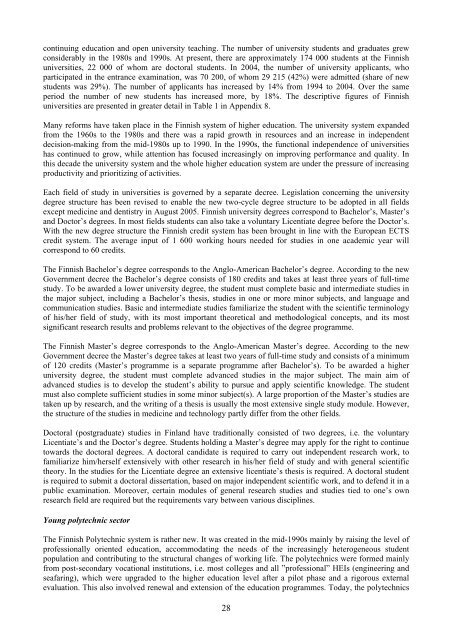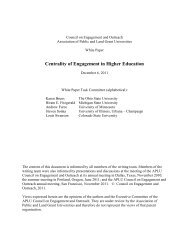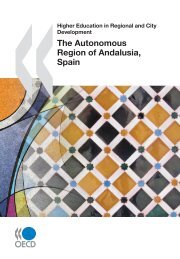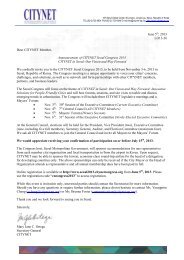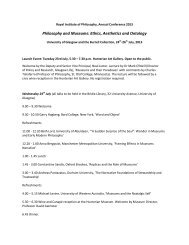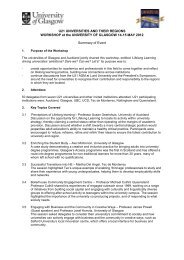Finland - Jyvaskyla Region - Final Self-Evaluation Report.pdf
Finland - Jyvaskyla Region - Final Self-Evaluation Report.pdf
Finland - Jyvaskyla Region - Final Self-Evaluation Report.pdf
Create successful ePaper yourself
Turn your PDF publications into a flip-book with our unique Google optimized e-Paper software.
continuing education and open university teaching. The number of university students and graduates grewconsiderably in the 1980s and 1990s. At present, there are approximately 174 000 students at the Finnishuniversities, 22 000 of whom are doctoral students. In 2004, the number of university applicants, whoparticipated in the entrance examination, was 70 200, of whom 29 215 (42%) were admitted (share of newstudents was 29%). The number of applicants has increased by 14% from 1994 to 2004. Over the sameperiod the number of new students has increased more, by 18%. The descriptive figures of Finnishuniversities are presented in greater detail in Table 1 in Appendix 8.Many reforms have taken place in the Finnish system of higher education. The university system expandedfrom the 1960s to the 1980s and there was a rapid growth in resources and an increase in independentdecision-making from the mid-1980s up to 1990. In the 1990s, the functional independence of universitieshas continued to grow, while attention has focused increasingly on improving performance and quality. Inthis decade the university system and the whole higher education system are under the pressure of increasingproductivity and prioritizing of activities.Each field of study in universities is governed by a separate decree. Legislation concerning the universitydegree structure has been revised to enable the new two-cycle degree structure to be adopted in all fieldsexcept medicine and dentistry in August 2005. Finnish university degrees correspond to Bachelor’s, Master’sand Doctor’s degrees. In most fields students can also take a voluntary Licentiate degree before the Doctor’s.With the new degree structure the Finnish credit system has been brought in line with the European ECTScredit system. The average input of 1 600 working hours needed for studies in one academic year willcorrespond to 60 credits.The Finnish Bachelor’s degree corresponds to the Anglo-American Bachelor’s degree. According to the newGovernment decree the Bachelor’s degree consists of 180 credits and takes at least three years of full-timestudy. To be awarded a lower university degree, the student must complete basic and intermediate studies inthe major subject, including a Bachelor’s thesis, studies in one or more minor subjects, and language andcommunication studies. Basic and intermediate studies familiarize the student with the scientific terminologyof his/her field of study, with its most important theoretical and methodological concepts, and its mostsignificant research results and problems relevant to the objectives of the degree programme.The Finnish Master’s degree corresponds to the Anglo-American Master’s degree. According to the newGovernment decree the Master’s degree takes at least two years of full-time study and consists of a minimumof 120 credits (Master’s programme is a separate programme after Bachelor’s). To be awarded a higheruniversity degree, the student must complete advanced studies in the major subject. The main aim ofadvanced studies is to develop the student’s ability to pursue and apply scientific knowledge. The studentmust also complete sufficient studies in some minor subject(s). A large proportion of the Master’s studies aretaken up by research, and the writing of a thesis is usually the most extensive single study module. However,the structure of the studies in medicine and technology partly differ from the other fields.Doctoral (postgraduate) studies in <strong>Finland</strong> have traditionally consisted of two degrees, i.e. the voluntaryLicentiate’s and the Doctor’s degree. Students holding a Master’s degree may apply for the right to continuetowards the doctoral degrees. A doctoral candidate is required to carry out independent research work, tofamiliarize him/herself extensively with other research in his/her field of study and with general scientifictheory. In the studies for the Licentiate degree an extensive licentiate’s thesis is required. A doctoral studentis required to submit a doctoral dissertation, based on major independent scientific work, and to defend it in apublic examination. Moreover, certain modules of general research studies and studies tied to one’s ownresearch field are required but the requirements vary between various disciplines.Young polytechnic sectorThe Finnish Polytechnic system is rather new. It was created in the mid-1990s mainly by raising the level ofprofessionally oriented education, accommodating the needs of the increasingly heterogeneous studentpopulation and contributing to the structural changes of working life. The polytechnics were formed mainlyfrom post-secondary vocational institutions, i.e. most colleges and all ”professional” HEIs (engineering andseafaring), which were upgraded to the higher education level after a pilot phase and a rigorous externalevaluation. This also involved renewal and extension of the education programmes. Today, the polytechnics28


